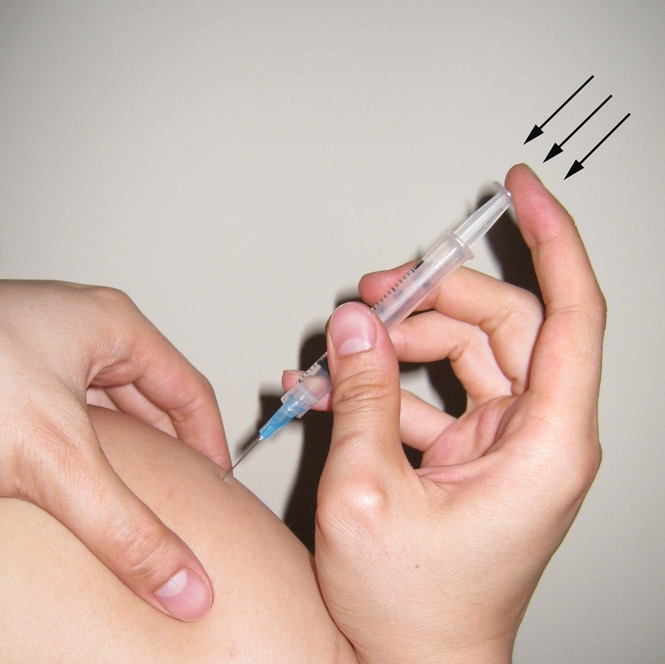Problem
You are a busy family physician with a large pediatric practice. Intramuscular injections for vaccination are a routine part of your clinic. The nurse in the clinic is often occupied, and you find yourself giving vaccinations without an extra set of hands. Despite the rare chance of injecting directly into a blood vessel, you are still appropriately in the practice of pulling back on the needle plunger before injecting. Your next patient arrives. You prepare the vaccine, position the patient, and then pierce the skin over the deltoid (Figure 1). You hold the needle with your dominant (right) hand, and your left hand moves to hold the needle (Figure 2). Your dominant hand then changes grip to pull back on the plunger (Figure 3). As you change grip, the child squirms away and the needle slips out (Figure 4). You wonder, How can I inject more efficiently and not have the needle slip as the patient squirms away? A review of the literature reveals that no one has addressed this issue previously.
Figure 1.

Dominant hand holding the needle and piercing the skin
Figure 2.

Nondominant hand holding the needle
Figure 3.

Dominant hand changing grip and pulling back on the plunger, giving the child the opportunity to break free
Figure 4.

Patient moving away from the needle and failure to inject the vaccine
Solution
You realize that the crux of the problem is having to change grips to pull back on the plunger. The solution? You decide to hold the needle like a dart, with the index and middle fingers placed below the plunger handle. Your thumb and fourth and fifth digits hold the barrel of the syringe (Figure 5). By extending your index and middle fingers, you can pull back on the plunger (Figure 6). The index finger then slides over the top of the plunger and pushes the plunger down (Figure 7). The result? You can pull back the plunger and inject the vaccine without changing grips. The free hand is then dedicated to keeping a secure grip on the child. Needle slippage is further prevented by resting the wrist of your dominant hand (the one doing the injecting) on the patient; in this way, if the patient moves, your wrist and hand move with the patient (Figure 7).
Figure 5.

Dominant hand holding the syringe like a dart
Figure 6.

Pulling back on the plunger by extending your index and middle fingers
Figure 7.

Pushing the plunger down with your index finger: Secure the patient with the nondominant hand and rest the wrist of the dominant hand so that you move with the patient.
With your next patient, you apply this new technique. As you no longer need to change grips, and because your hand moves with the patient as he instinctively moves away, you quickly, efficiently, and successfully inject the vaccine.
We encourage readers to share some of their practice experience: the neat little tricks that solve difficult clinical situations. Praxis articles can be submitted online at http://mc.manuscriptcentral.com/cfp or through the CFP website at www.cfp.ca under “Authors.”
Footnotes
Competing interests
None declared


